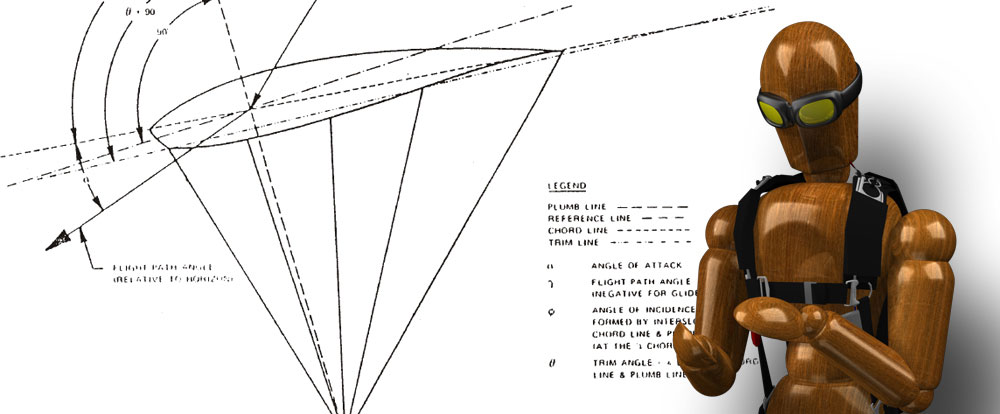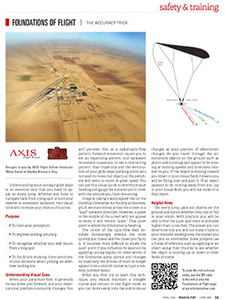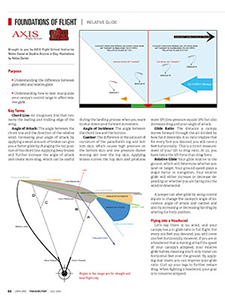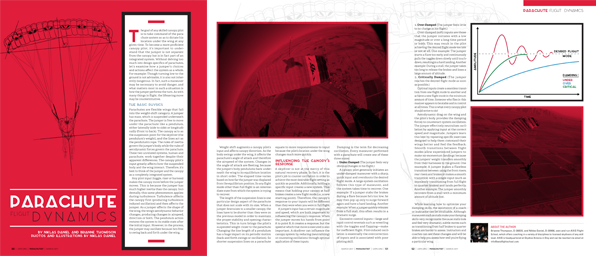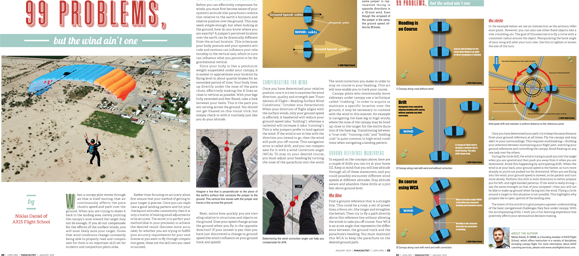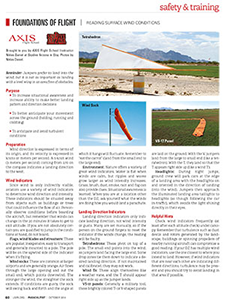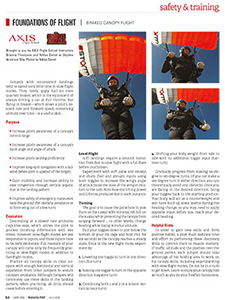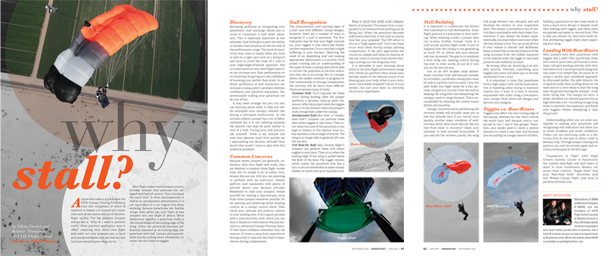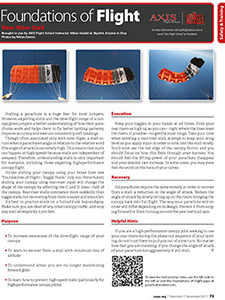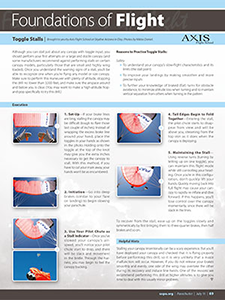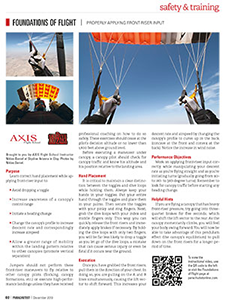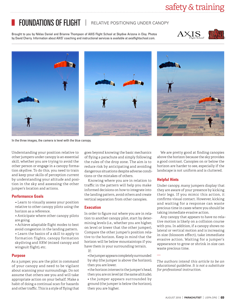Table of Contents
Jump to a chapter/section by clicking on it
or scroll through the complete topic.
Chapter 1: Advanced Accuracy
Chapter 2: B License Weekend
Chapter 3: Canopy Piloting Program
Chapter 4: In-Air Canopy Skills Program
Chapter 1: Advanced Accuracy


The Accuracy Trick
Article by Niklas Daniel. Visuals by by Niklas Daniel.
Understanding your canopy's glide slope is an essential skill that you need to apply on every jump. Whether you have to navigate back from a long spot or land your reserve in someone's backyard, this visual trick will increase your chance of success.
[ Full Article ]
[ Video ]


Relative Glide
Article by Niklas Daniel. Visuals by and illustrations by Niklas Daniel.
Understanding the difference between glide ratio and relative glide as well as how to best manipulate your canopy's control range to affect relative glide.
[ Full Article ]
[ Video ]

Parachute Flight Dynamics
Article by Niklas Daniel and Brianne Thompson. Visuals by and illustrations by Niklas Daniel.
To become a more proficient canopy pilot, it's important to understand that the jumper is not separate from the canopy but is in fact part of an integrated system. Without delving too much into design specifics of parachutes, let's examine how a jumper's choices and actions affect the system as a whole.
[ Full Article ]

99 Problems, but the Wind ain't One
Article by Niklas Daniel. Visuals by by Niklas Daniel.
When a canopy pilot moves through air that is itself moving, that air continuously affects the parachute's speed and path over the ground. When you are trying to make it back to the landing area, merely pointing the canopy's nose toward the target may not be enough.
[ Full Article ]

Reading Surface Wind Conditions
Article by Niklas Daniel. Visuals by by Niklas Daniel.
Increase situational awareness and increase ability to make better landing pattern and direction decisions. Better anticipate your movement across the ground (holding, running and crabbing). Anticipate and avoid turbulent conditions.
[ Full Article ]
Chapter 2: B License Weekend

Braked Canopy Flight
Article by Brianne Thompson and Niklas Daniel. Visuals by by Niklas Daniel.
The purpose of this drill is to increase a pilot's awareness of a canopy's control range, awareness of a canopy's bank angle and angle of attack, landing proficiency, and long-spot navigation with a tail-wind. It also helps to gain mobility and increase the ability to ease congestion in the landing pattern as well as improve safety of emergency maneuvers near the ground.
[ Full Article ]


Relative Glide
Article by Niklas Daniel. Visuals by and illustrations by Niklas Daniel.
Understanding the difference between glide ratio and relative glide as well as how to best manipulate your canopy's control range to affect relative glide.
[ Full Article ]
[ Video ]

Why Stall?
Article by Niklas Daniel and Brianne Thompson. Visuals by by Niklas Daniel.
Anyone who takes a quick look at the USPA Canopy Piloting Proficiency Card will notice that most of the maneuvers are of the slowflight variety. The big question is, "Why do I need to perform stalls? What practical application does it offer?" Learning more about slow flight and stalls not only prepares you to land your parachute better, but also teaches you just how versatile your wing can be.
[ Full Article ]


Rear-Riser Stall
Article by Niklas Daniel and Brianne Thompson. Visuals by by Paul Youcupicio.
Stalling a parachute is a huge fear for most jumpers. However, exploring stalls and the slow-flight range of a canopy gives jumpers a better understanding of how their parachutes work and helps them to fly better landing patterns, improve accuracy and execute consistently soft landings.
[ Full Article ]
[ Video ]

Toggle Stalls
Article by Niklas Daniel and Brianne Thompson. Visuals by by Niklas Daniel.
Reasons to practice toggle Stalls are to understand your canopy's slow-flight characteristics and its limits (the stall point), to improve your landings by making smoother and more precise inputs, to further your knowledge of braked (flat) turns for obstacle avoidance, and to minimize altitude loss when turning and to maintain vertical separation from others when turning in the pattern.
[ Full Article ]


Training for Water Landings — More Than Just a Sign-Off
Article by Niklas Daniel and Brianne Thompson. Visuals by by Samantha Schwann.
Training for intentional and unintentional water landings is an important part of a skydiver's learning progression and is required to receive the USPA B license. Unfortunately, most jumpers rarely give it much thought after their instructors sign them off for this skill, and few take the time to carefully consider the dangers involved.
[ Full Article ]
[ Video ]

Reading Surface Wind Conditions
Article by Niklas Daniel. Visuals by by Niklas Daniel.
Increase situational awareness and increase ability to make better landing pattern and direction decisions. Better anticipate your movement across the ground (holding, running and crabbing). Anticipate and avoid turbulent conditions.
[ Full Article ]
Chapter 3: Canopy Piloting Program


Properly Applying Front-Riser Input
Article by Niklas Daniel. Visuals by by Niklas Daniel.
Learn correct hand placement while applying front-riser input to: avoid dropping a toggle, increase awareness of a canopy's control range, initiate a heading change, change the canopy's profile to increase descent rate and correspondingly increase airspeed, and allow a greater range of mobility within the landing pattern relative to other canopies.
[ Full Article ]
[ Video ]
Chapter 4: In-Air Canopy Skills Program

Relative Positioning Under Canopy
Article by Niklas Daniel and Brianne Thompson. Visuals by by David Cherry.
Understanding your position relative to other jumpers under canopy is an essential skill, whether you are trying to avoid the other person or engage in a canopy formation skydive. To do this, you need to train and keep your skills of perception current.
[ Full Article ]
